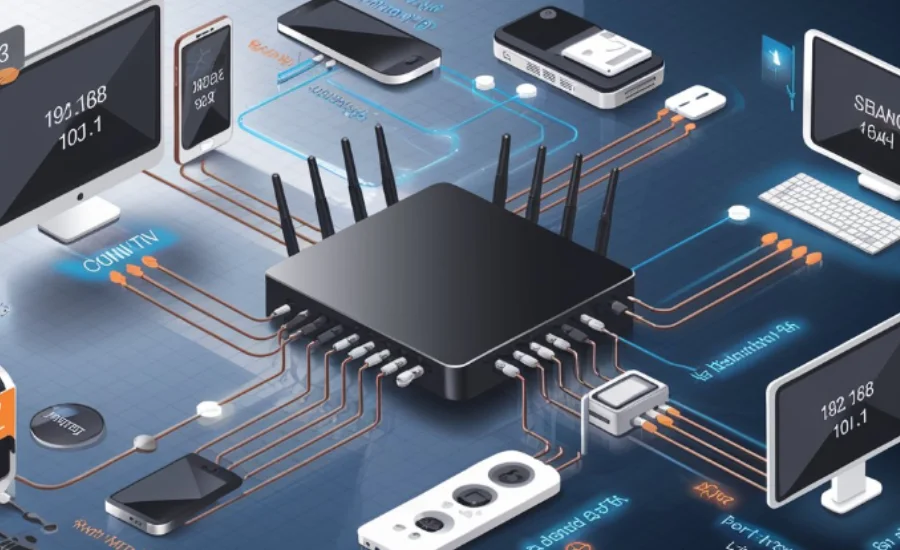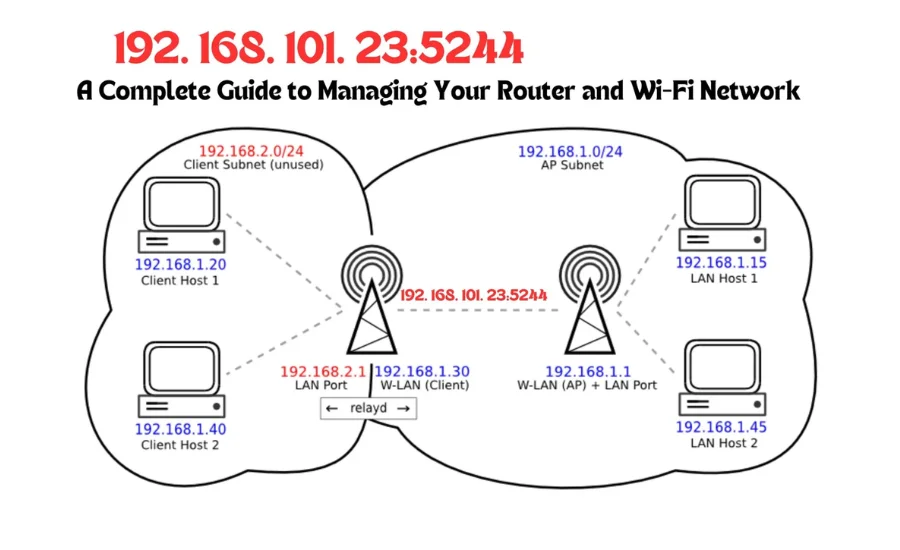Understanding the intricacies of network setups, such as IP addresses and port numbers, is crucial for preserving safe and efficient networks in our increasingly interconnected digital world. The IP address and port combination 192.168.101.23:5244 is the subject of this article, which also looks at its usefulness, practical usage, and management techniques for private and business networks.
When data is sent between devices on a network, the combination of an IP address and port number is essential. A device’s IP address acts as a unique identity, and its port number designates a certain service or application. In this instance, port 5244 is normally given for a particular application or service, enabling focused data transmission, but IP address 192.168.101.23 indicates a device on a private network, frequently used for internal communications.
Understanding how to effectively manage this combination is crucial for network administrators. For instance, in corporate settings, utilizing specific IP addresses and port numbers helps streamline communication between servers and client devices, optimizing performance and security. Proper configuration can prevent unauthorized access and ensure that data is directed to the correct application, thereby enhancing overall network integrity.
In summary, the IP address and port combination of 192.168.101.23:5244 is a fundamental aspect of network management, vital for ensuring smooth and secure data flow. Recognizing its significance aids in the effective administration of both private and corporate networks, allowing for improved performance and security in today’s interconnected world.
The Role of IP Addresses in Network Connectivity

An IP address, or Internet Protocol address, serves as a distinctive label for devices connected to a network. This identifier is essential for enabling various devices, ranging from smartphones to robust servers, to effectively transmit and receive data. There are two primary formats for IP addresses:
IPv4: This is the most widely adopted format, comprising four sets of numbers known as octets (e.g., 192.168.101.23).
IPv6: Introduced to accommodate the increasing number of devices online, this version features longer and more complex addresses.
The IP address 192.168.101.23:5244 is classified as a private IP address, meaning that it is used in local networks, such those found in homes or offices. Devices connected to the same network can safely interact with one other since their addresses are not routable on the open internet. A router makes it easier for devices to connect to external networks by allocating a public IP address, which allows data to flow correctly between the public and private domains.
Understanding the function of IP addresses is crucial for network management, as it lays the groundwork for secure and efficient communication among devices.
Understanding Private IP Address Ranges and Their Functions
The IP address 192.168.101.23:5244 is classified within a set of addresses designated as private IP addresses. These addresses are specifically allocated for internal use within private networks, such as those found in homes and businesses, and are not routable on the internet.
Private IPv4 address ranges include:
- 10.0.0.0 – 10.255.255.255
- 172.16.0.0 – 172.31.255.255
- 192.168.0.0 – 192.168.255.255
192.168.101.23:5244 is a valid IP address inside the 192.168.x.x range, indicating that it is a part of a private network, most likely a local area network (LAN). In a network like this, devices may communicate with each other without any problems. These devices must, however, route their requests through a gateway device, such as a router, in order to access the internet. In order to enable connection with the public internet, this router often uses network address translation, or NAT. This allows private network devices to access external resources while keeping their private IP status.
The Function of Port Numbers in Network Communication
A port number acts as a virtual entry point for initiating or concluding network connections. You can think of it as a door that facilitates communication between a device and other devices or services. Port numbers range from 0 to 65,535 and are divided into three main categories:
- Well-Known Ports (0-1023): These are reserved for standard services, such as HTTP (port 80) and HTTPS (port 443).
- Registered Ports (1024-49151): These are allocated for specific applications or services.
- Dynamic/Private Ports (49152-65535): Typically utilized for temporary connections or client-side communication.
The port number 5244 in the context of 192.168.101.23:5244 is inside the registered range, meaning that its particular application may vary depending on the program or service being used. Comprehending port numbers is imperative for proficient network administration, as they aid in defining the transmission and reception of data across various applications and gadgets.
Ensuring Network Health Through Effective Troubleshooting
Troubleshooting issues related to the IP address 192.168.101.23:5244 is essential for maintaining optimal network performance. Key steps in this process include verifying device configurations, checking for any potential IP address conflicts within the network, and ensuring that port 5244 remains unobstructed by security protocols.
Network Diagnostics: Employing diagnostic tools such as ping or traceroute can help assess connectivity to the address 192.168.101.23, allowing for quick identification of any network issues.
Security Assessments: It is crucial to routinely update device firmware and monitor port 5244 for any unauthorized access attempts. These proactive measures help safeguard the network against potential threats and ensure reliable communication between devices. By adhering to these practices, network administrators can significantly enhance the overall health and security of their networks.
Best Practices for Securing a Network Environment

To effectively secure a network environment that utilizes the IP address 192.168.101.23 and port 5244, it is essential to adopt several best practices:
Firewall Configuration: Establishing strong firewall rules is crucial for managing traffic that flows to and from port 5244. This ensures that only authorized communications are allowed, helping to mitigate potential security threats.
Access Controls: Implementing stringent access controls is vital to regulate which users or devices can interact with the network resources associated with 192.168.101.23:5244. By restricting access to trusted individuals or systems, you can significantly reduce the risk of unauthorized access and enhance the overall security of the network.
Adopting these strategies not only strengthens network defenses but also fosters a safer environment for data exchange and device interaction.
Possible Applications of the IP Address 192.168.101.23:5244
Networked Devices: This IP address and port could be assigned to devices such as printers, cameras, or Internet of Things (IoT) devices within a local network, enabling them to communicate effectively with other devices.
The combination of 192.168.101.23:5244 can serve various functions depending on the specific environment in which it is utilized. Here are several potential scenarios:
Gaming or Custom Servers: In the realm of online gaming or certain applications, random ports may be allocated for interactions between players or between clients and servers, facilitating seamless gameplay and communication.
Internal Services: Within corporate settings, specific IP addresses and port combinations are often designated for internal services, including databases or application servers. This arrangement ensures efficient communication and data exchange among various internal resources.
Each of these scenarios highlights the versatility of the IP address and port combination, demonstrating its importance in facilitating connectivity across different devices and services.
The Importance of IP Addresses and Port Numbers in Networking
When it comes to networking, the IP address and port number are both essential for guiding traffic to the right place. When combined, they form what’s referred to as a socket, which gives a service running on a particular device a unique identity.
The Role of Routers
Routers are vital components in managing traffic among various devices within a network. Upon receiving a request, a router analyzes the destination IP address and forwards the traffic accordingly. If the request includes a port number, the router can determine which particular service to direct the traffic toward on that device.
Internal Communication: Devices within the same local network—such as multiple computers in a home or office—can interact directly through private IP addresses and ports.
External Communication: For devices situated outside the local network, a public IP address is necessary, often utilizing Network Address Translation (NAT). The router performs this translation by converting the private IP address and port into a public address, enabling communication across the wider internet.
Understanding the interplay between IP addresses, port numbers, and routers is fundamental for ensuring efficient data routing and service access in both local and external networks.
The Significance of 192.168.101.23:5244 in Advanced Network Configurations
In more intricate network setups, the combination of 192.168.101.23:5244 can play a critical role. For example, when employing reverse proxies or specialized network services, this IP address and port number can enhance operational efficiency and bolster security by isolating traffic and reducing the direct exposure of vital services to the public internet.
Reverse Proxy Usage: Implementing 192.168.101.23:5244 behind a reverse proxy allows for secure and controlled access to web services. This setup not only manages incoming traffic but also helps in load balancing and providing an additional layer of protection against potential threats.
Network Segmentation: The IP address and port can also be utilized to create segments within the network that safeguard sensitive information or critical operations. By isolating these areas, organizations can limit access and reduce the risk of unauthorized intrusion, ensuring that essential data remains protected.
Leveraging 192.168.101.23:5244 in these contexts illustrates its importance in modern network architectures, particularly regarding enhancing security and optimizing service access.
The Role of VLANs in Managing Network Traffic with 192.168.101.23:5244

Virtual Local Area Networks (VLANs) are essential for controlling data flow in networks that use settings like 192.168.101.23:5244. Administrators can regulate which devices are allowed to communicate over a given IP address and port by dividing a network into VLANs. This method separates broadcast domains inside the network, which improves security.
VLAN Configuration: By assigning 192.168.101.23:5244 to a designated VLAN that limits traffic to only essential devices and communications, organizations can significantly mitigate the risk of internal threats. This targeted configuration helps ensure that sensitive data remains within a controlled environment, thereby reducing vulnerabilities and enhancing overall network security.
Utilizing VLANs effectively demonstrates a strategic approach to network management, allowing for improved traffic control and heightened security measures around critical services.
Troubleshooting Issues with 192.168.101.23:5244
If you are experiencing difficulties with the IP address and port combination of 192.168.101.23:5244, consider following these troubleshooting steps:
1. Verify Device Configurations: Start by checking that the device assigned the IP address 192.168.101.23 is operating correctly. Ensure that the service utilizing port 5244 is configured properly and functioning as intended.
2. Review Firewall Settings: Confirm that port 5244 is open on any firewalls or routers within your network. Occasionally, network security measures may block specific ports, hindering communication.
3. Check for Network Conflicts: Ensure that there are no duplicate private IP addresses assigned to multiple devices. Conflicts of this nature can disrupt communication and lead to connectivity issues.
By following these steps, you can help identify and resolve potential problems related to the use of 192.168.101.23:5244, ensuring a more stable and reliable network environment.
Understanding Security Risks Associated with IP Addresses and Port Numbers
Utilizing IP addresses and port numbers can expose devices to various security vulnerabilities, particularly when configurations are inadequate or ports are left accessible to the public internet. Some prevalent security concerns include:
Open Ports: Unprotected open ports can become entry points for unauthorized users, potentially resulting in data breaches or system compromises.
Port Scanning: Cybercriminals often employ port scanning tools to identify active services on a device, searching for weaknesses they can exploit.
Misconfiguration: Incorrectly set firewall or router configurations can inadvertently expose services to the public internet, increasing susceptibility to attacks.
To address these vulnerabilities, it is essential to take proactive measures, including:
- Firewall Implementation: Utilize firewalls to block any unused ports, minimizing potential entry points for attackers.
- Correct Port Forwarding: Ensure that port forwarding is implemented properly, allowing exposure of only the necessary services to external networks.
- Regular Updates and Patching: Consistently update and patch the services operating within your network to mitigate vulnerabilities and enhance security.
By adopting these strategies, organizations can significantly reduce the risks associated with the use of IP addresses and port numbers, creating a safer network environment.
Read More: Understanding and Managing the Implications of the Number 4386220871
Final Words
Comprehending the nuances of IP addresses and port numbers is essential for ensuring safe and effective network operations in the linked digital world of today. Risks related to open ports, incorrect settings, and unauthorized access may be greatly reduced with proper administration and setup. Strong security measures, such firewalls, proper port forwarding, and frequent upgrades, may be put in place by enterprises to fortify their network environment and secure critical data while maintaining smooth device integration. It is important to prioritize these areas in order to prevent potential vulnerabilities and maintain a robust network architecture.
For more information Check It Out TrendyRevolve




